Analysis of the causes and circumstances of an accident • Educational project "The right driver"
It is better not to make mistakes while driving - everyone knows this. However, very few people are capable of driving a car perfectly. According to research, a driver makes an average of 5 to 10 mistakes in 15 minutes of driving in the city. Of course, their danger is different, but each of these errors to a certain extent increases the likelihood of a traffic accident, as well as the overall intensity of the driver's work.
Most of the mistakes made by the driver go unnoticed by him, since they, due to the compensatory actions of other drivers or a fortunate combination of circumstances, do not immediately result in dangerous situations or incidents. As a result a large number repetitions of errors are fixed in a stable style of driver behavior and, ultimately, become cause of the accident. Therefore, knowing your mistakes in driving, understanding their causes and preventing them is very important for every driver.
Driver errors are quite numerous and varied. We will focus on the most common. To do this, we analyze typical situations in which these errors have become main reason car accident.
Observation errors
Situation 1. The driver of car A drives up the secondary road to the intersection with the main one, where he is going to turn right (Fig. 38). Car B is ahead of him, the driver of which signaled a right turn and stops to let traffic moving along the main road pass. When there is an interval, the driver of car B starts the turn. The driver of car A starts immediately behind him and at the same time watches only the traffic moving on the main road. Leaving on it, he makes a collision with a suddenly stopped car B.
The mistake of driver A is that he stopped watching the leading car and did not notice how he suddenly stopped. Estimating whether he had enough time to complete the maneuver, he forgot about the car in front, assuming that he had already completed the maneuver.
The reasons for the sudden stop of car B can be caused by the following circumstances: the engine has stalled; the driver of car B decided to wait for safer conditions for the turn; movement was obstructed.
The probability of an error increases with a high traffic flow on the main road, a large queue of cars (waiting for the opportunity to enter the main road), poor lighting. Car collisions are even more likely on slippery roads.
Situation 2. The driver of car A, ahead of the bus that started moving from the stop, suddenly saw a pedestrian crossing the road in the immediate vicinity of him (Fig. 39). Avoiding a collision with a pedestrian, as well as a head-on collision with an oncoming car B, the driver of car A began to brake and turn to the right, while colliding with a bus, which he completely forgot about.
The driver's mistake was that he did not notice the pedestrian who had begun to cross the road in time, and did not slow down in such a situation. The reason for the late detection of the pedestrian is that he did not examine the entire situation ahead, including the roadside area, on which there was a group of people waiting for the opportunity to cross the road to get on the bus approaching the stop. The driver focused only on vehicles on the roadway.
The probability of an error is increased if there are "points of attraction" for pedestrians on the opposite side of the bus stop, such as shops, cinemas, etc.
Situation 3. The driver of car A, moving at a speed of 90 km / h on a suburban road, starts overtaking the vehicle (Fig. 40). The driver of an oncoming large vehicle turned right to the side of the road and slowed down to make the maneuver easier. The driver of car B, not seeing car A, starts to overtake the truck. As a result, cars A and B collide.
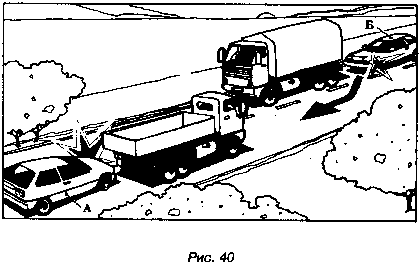
The error of the drivers of cars A and B is due to the late detection of each other. Observing the situation in the immediate vicinity of your car is a typical mistake of novice drivers. The lack of control of the situation at a sufficiently large distance ahead leads to the late detection of avoidable hazards.
Situation 4. The driver of the passenger car started a U-turn not far from the bus standing at the bus stop (Fig. 41). Looking in the rear-view mirror, he did not notice another car approaching from behind in the same direction, as the bus standing behind reduced the view of the road. When turning around, the driver concentrated his attention on oncoming traffic, watching the truck. The car that left behind the bus collided with a turning car.

The driver error here is due to the lack of re-observation of the place possible appearance danger. The reason for this was an underestimation of the likelihood of a danger, as well as a complete distraction of attention to other objects of the traffic situation. The probability of an error increases with a small distance of a turning car from a standing bus, as well as with a high intensity of traffic in the oncoming lane, a small width of the carriageway, and a large length of a turning vehicle.
In order to notice the danger in time, it is necessary to fully examine the entire visible situation on the road and around it, constantly switching your gaze from one place to another.
Situation 5. The driver of a car wants to change lanes for a left turn (Fig. 42). After looking in the rear-view mirror and at the same time giving a left turn signal, he starts to drive into the left adjacent lane, where he collides with another car moving along the same lane in the same direction.

The driver's mistake is due to the fact that he did not take into account the situation in the area not visible through the rear-view mirror to the left of his car.
The likelihood of such an error increases in the following cases: if the rear-view mirror is incorrectly adjusted; confidence that when a left turn signal is given, the driver of a vehicle moving behind will give way; with a shortage of time and space remaining for rebuilding to the left lane; poor knowledge of the route, high traffic density, dirty car windows.
Situation 6. Bus driver pulling up to bus stop public transport, began boarding passengers (Fig. 43). The bus was already almost completely filled with passengers, so there were difficulties when closing the doors: some of the passengers could not get on the bus.
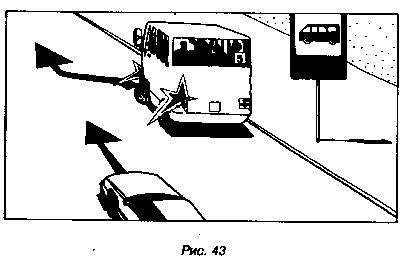
The driver signaled a left turn and pulled the car off, while continuing to watch the doors. When the bus was leaving, it collided with a car moving on the left adjacent lane.
The bus driver's mistake is that he did not control the situation on the left, concentrating on the boarding of passengers.
Situation 7. Driver truck approaches a regulated intersection with the intention of turning right (Fig. 44). Having signaled a right turn, he stops waiting for a green traffic light. With right side it leaves a little space to avoid hitting the pavement when turning. Having moved from a place to a traffic light signal, the car collides with a motorcycle that has also started moving.

The error of the driver of the truck is connected with the lack of control over the situation to the right of him. The motorcyclist, standing on the right, enters an area that is not accessible to the driver of a heavy vehicle, so he had to look out the right window.
The error is more likely to occur when making a turn without first stopping at an intersection, when there is a large amount of free space between the truck and the right edge of the road.
Communication errors
Case 8 The driver of a car standing at the right edge of the road starts moving after parking (Fig. 45). When leaving without prior warning, the driver turns the steering wheel sharply to the left to avoid the truck in front. At the same time, he forgets to control the situation behind and to the left. As a result, there is a collision with a car, the driver of which noticed the maneuver of the passenger car only when it almost drove into its lane.
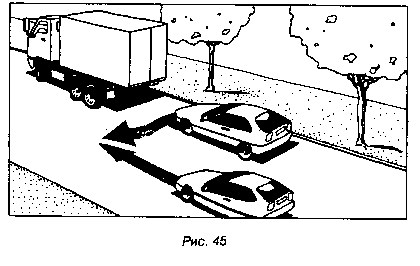
The driver's mistake here is that he started moving without checking the situation on the left and behind and without turning on the left turn signal. Errors contributing to the accident are also unexpected for other road users a quick exit to the left neighboring lane due to a sharp turn of the steering wheel and high acceleration at the beginning of the movement.
The likelihood of errors increases due to haste or extreme fatigue, in the presence of objects or events that distract the driver's attention. For example, he may be hindered by those in front vehicles, small room for maneuver, standing behind a large road train or bus.
Situation 9. The truck driver intends to make a turn into a narrow passage adjoining the road on the left (fig. 46). Since the road is not wide, he decides to start the turn from the far right. To do this, includes a right turn indicator.

Having taken to the right, it stops against the passage. Having cast a cursory glance in the side view mirror and not seeing the passenger car behind him in the blind area, he starts the turn, forgetting to turn off the right turn indicator. The driver, believing that the truck has stopped, begins to go around it. There is a collision.
The truck driver made the following mistakes: he forgot to turn off the right turn indicator, which misled the driver of the car; didn't take a good look at the back.
The likelihood of making such a mistake increases with poor knowledge of the route, improper adjustment of the side-view mirrors, poor visibility, increased difficulty in making a turn due to insufficient space and large vehicle dimensions. The probability of an accident as a result of an error increases with a sharp start of the maneuver after a stop, the presence of oncoming traffic.
Situation 10. The driver of the road train, approaching an unregulated intersection, gave a right turn signal just before the start of the turn (Fig. 47). In order not to drive onto the right side of the sidewalk, the driver left a distance of 1.5 m on the right. Since the driver did not notice any visible obstacles to maneuver, he starts turning on the move, without stopping. There is a collision with a motorcyclist, also on the move trying to pass the intersection in forward direction. Since the turn signal was given by the driver of the car just before the maneuver, the motorcyclist did not see him and believed that the vehicle would move straight ahead.
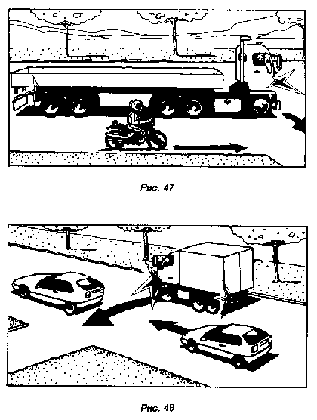
The driver of the road train made the following mistakes: he turned on the right turn indicator late, did not control the situation on the right. A related error is turning at high speed.
The likelihood of an accident as a result of an error increases at high turning speeds, as well as in inclement weather, when the direction indicators can be splashed with mud!
Situation 11. The truck driver, intending to take the leftmost lane, looked in the side view mirror and gave a left turn signal, immediately began to change lanes (Fig. 48), where he collides with a car moving behind along this lane.
The truck driver made the following mistakes: he underestimated the speed of the car and the distance to it; late gave a signal warning of the intention to make a maneuver, which did not allow the driver of the car to react in time and act correctly. Concomitant errors of a truck driver can be: a sharp change in direction of movement (a sharp turn of the steering wheel to the left) and a sharp braking after a lane change, caused by a decrease in the flow rate due to the approach to the intersection.
The probability of making a mistake increases with high traffic density, poor vehicle dynamics, high speeds, poor visibility and at night. The probability of an accident as a result of an error increases with a large difference in the braking characteristics of vehicles, large dimensions of the truck, slippery pavement.
Case 12. Moving at a speed of 50 km / h along the road with oncoming traffic, the driver of a car, without slowing down, begins to go around the bus at the bus stop (Fig. 49). Suddenly, a pedestrian appears in front of him, stepping out from behind the bus. The driver of the car collides with him, trying to avoid a collision, enters the lane of oncoming traffic, and collides with an oncoming vehicle.

The driver's mistake is to choose too high a speed when bypassing the bus. The chosen speed of movement in such a situation does not allow him to prevent a collision with a pedestrian without leaving the lane of oncoming traffic. The recommended speed when passing a bus standing at a bus stop is 15-20 km/h. In addition, a headlight warning signal can be given to warn of a possible conflict.
Causes of driver errors are usually associated with an underestimation of the probability of pedestrians getting off because of the bus and the speed of their movement. The likelihood of an error increases due to the fact that the driver is distracted from observing the situation, as well as due to the high traffic intensity.
The probability of an accident as a result of an error increases with a large mass and dimensions of the car, a short interval to the bus, poor visibility of the situation ahead due to adverse atmospheric conditions or pollution windshield, narrow roadway, slippery road surface, high pedestrian speed.
Case 13. A car driver, moving at a speed of 60 km/h, approaches an unmarked pedestrian crossing (Fig. 50). Several people are standing to the left of the pedestrian crossing. A truck is moving in the opposite direction. 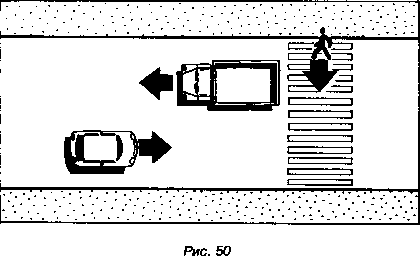
The driver of the car, without slowing down, drives up to the pedestrian crossing. At the same time, the visibility of the situation on the left at the crossing is blocked for him by an oncoming vehicle, due to which a pedestrian suddenly appears, quickly crossing the road along the pedestrian crossing. The driver of the car was unable to prevent the collision.
The driver's mistake is to choose a high speed when passing a marked pedestrian crossing in the presence of vehicles blocking the view. The reason for the error is associated with an underestimation of the probability of a pedestrian appearing at the moment of crossing a pedestrian crossing or untimely detection of a pedestrian crossing.
The probability of hitting a pedestrian as a result of an error increases with a small width of the carriageway, the presence of a large vehicle that obscures the view of the situation. The severity of the consequences of an error increases with slippery surfaces and a small width of the roadway.
Situation 14. A truck driver, moving along the main road, is about to turn onto the road adjacent to the right (Fig. 51). Turning at a speed of 30 km / h, he enters the oncoming traffic lane, where he collides with a car approaching the main road.
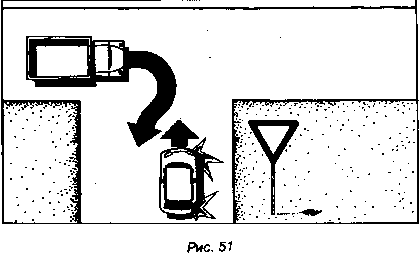
In this situation, it is also possible to run into a pedestrian standing in the middle of the road waiting for a truck to pass.
The error of the truck driver is the wrong choice of speed, resulting in an increase in the turning radius of the car. The reason for this is an underestimation of the consequences of performing a maneuver at a given speed.
The probability of an accident as a result of a driver's error increases in the presence of objects blocking the view (buildings, plants), the small width of the carriageway of the adjacent road, and heavy pedestrian traffic on the adjacent road.
Situation 15. The driver of a car is approaching the regulated intersection along the free extreme right lane of the road at the moment the red traffic light changes to yellow (Fig. 52). Several vehicles stand at the stop lines waiting for a green traffic light. Among them is a large 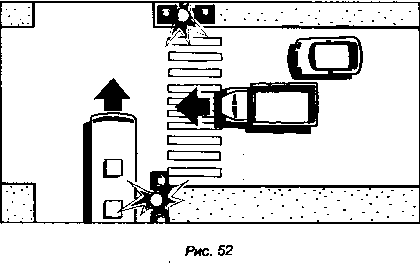 the vehicle closes the view of the situation at the intersection. The driver, without slowing down, enters the intersection when the yellow signal changes to green and collides with the bus that completes the intersection in the crossing direction. Another type of incident in such a situation could be a collision with a pedestrian completing a road crossing.
the vehicle closes the view of the situation at the intersection. The driver, without slowing down, enters the intersection when the yellow signal changes to green and collides with the bus that completes the intersection in the crossing direction. Another type of incident in such a situation could be a collision with a pedestrian completing a road crossing.
The driver's mistake consists in choosing a high speed when approaching the intersection in conditions of limited visibility of the situation, which leads to a significant advance of other vehicles that start moving at the traffic light.
The reason for the error is related to the underestimation of the probability of other traffic participants appearing at the intersection at the moment the yellow traffic light changes to green.
The probability of an accident as a result (errors) increases with a short phase of changing the yellow signal to green, with a large intersection, with heavy traffic on it.
Braking
Case 16. The driver of a car moving along a roundabout of the road sees that the bus in front slows down and stops (Fig. 53). Before going around it, the driver of a car decides to slow down, for which he sharply presses the brake pedal.
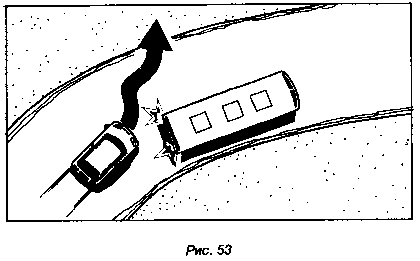 As a result, the car skids, it enters the oncoming lane and overturns on the side of the road. This situation also threatens a collision with an oncoming vehicle or a collision with an immovable obstacle or a stationary vehicle as a result of skidding.
As a result, the car skids, it enters the oncoming lane and overturns on the side of the road. This situation also threatens a collision with an oncoming vehicle or a collision with an immovable obstacle or a stationary vehicle as a result of skidding.
The mistake of the car driver is to apply (to slow down) emergency braking with full wheel lock, which is the most common cause of a car skidding. A traffic accident can be facilitated by the choice of high speed, distraction, short distance, improperly formed skill of emergency braking.
The probability of a traffic accident as a result of an error increases with a small turning radius, slippery road surface, worn tires of the car, narrow road width, heavy traffic.
Situation 17. A truck with a trailer is moving down a narrow road (Fig. 54). A car is approaching at high speed. The truck driver pulls his vehicle to the right and brakes hard with the wheels completely locked. The trailer swerves to the left and collides with a car.
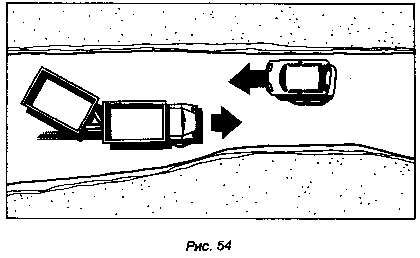
Driver error - braking with full wheel lock. The reason contributing to the accident may be the choice of too high speed.
The probability of an accident as a result of an error increases with a steep slope, poor and slippery road surfaces, and malfunctions in the trailer brake system.
Other types of accidents in this situation can be: overturning, passing collision with a car in front.
The probability of making an accident as a result of errors increases with slippery road surfaces, high traffic density, a large difference in the braking characteristics of vehicles, and the inability of the driver to eliminate the skid of the car.
Situation 18. A truck, moving at a speed of 50 km/h behind the leading passenger car, drives up to a regulated intersection (Fig. 55). The traffic light changes from green to yellow. 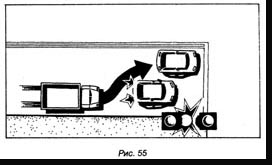 The truck driver believes that the passenger car will not stop before the intersection, but will pass it on the yellow signal. Therefore, it does not reduce the speed of movement. The car brakes sharply in front of the intersection. The truck driver presses hard on the brake pedal, completely blocking the vehicle's wheels. As a result, the car skids, and he leaves for the adjacent left lane, where he collides with the vehicle on it.
The truck driver believes that the passenger car will not stop before the intersection, but will pass it on the yellow signal. Therefore, it does not reduce the speed of movement. The car brakes sharply in front of the intersection. The truck driver presses hard on the brake pedal, completely blocking the vehicle's wheels. As a result, the car skids, and he leaves for the adjacent left lane, where he collides with the vehicle on it.
The truck driver made the following mistakes: did not slow down when approaching the intersection, chose a small distance to the leading car; applied emergency braking with full blocking of the wheels.
Situation 19. A car at a speed of 80 km/h approaches a steep slope of the road (in 4th gear) and, without slowing down, begins to overcome the slope. Due to imperfections in the road surface, the driver is forced to brake, as a result of which the car begins to lose speed and the engine stalls. The driver is trying to start the engine by putting the car on the handbrake. However, because of the ice, the car begins to roll back and, having left the carriageway, overturns.
The driver's mistake is the wrong choice of gear to overcome the rise. Steep climbs are recommended to be overcome in second gear.
The probability of an accident as a result of an error increases with a large mass of the car, worn tires, a large steepness and duration of the ascent, and sudden braking when climbing.
Distance selection
Situation 20. A passenger car moves in a dense traffic flow behind a truck and approaches a regulated intersection (Fig. 56). The traffic light is green  signal, so the driver of the car intends, without slowing down, to pass the intersection in the forward direction. The distance to the truck is 6 m. Just before the intersection, the truck driver suddenly gives a right turn signal and brakes. A collision occurs.
signal, so the driver of the car intends, without slowing down, to pass the intersection in the forward direction. The distance to the truck is 6 m. Just before the intersection, the truck driver suddenly gives a right turn signal and brakes. A collision occurs.
The mistake of the driver of a car is the wrong choice of distance. He did not take into account the possibility of braking the leading car. The probability of making a mistake increases with high traffic intensity.
The likelihood of an accident due to an error is increased when the lead vehicle's turn warning signal is late or not signaled. Here, the difference in the braking characteristics of cars, slippery surfaces, and high speed are also important.
Situation 21. A passenger car is moving at a speed of 50 km / h behind a truck (Fig. 57). The driver of a passenger vehicle decides to overtake a truck  automobile. Having started overtaking, he sees an oncoming bus, which can interfere with the maneuver. While waiting for this bus to pass, the driver of the car sharply reduces the distance to the truck, goes almost close to it. The truck brakes sharply, as a pedestrian appears on the carriageway in front of it, crossing the road (there may be other reasons for braking: a pit or unevenness on the carriageway; an unexpected maneuver of oncoming traffic; standing, stopping, entering the road from the yard or from adjoining road car). There is a passing collision between a car and a truck, or the driver of a car, trying to avoid a collision with a truck, enters the oncoming lane, and then his car collides with a bus.
automobile. Having started overtaking, he sees an oncoming bus, which can interfere with the maneuver. While waiting for this bus to pass, the driver of the car sharply reduces the distance to the truck, goes almost close to it. The truck brakes sharply, as a pedestrian appears on the carriageway in front of it, crossing the road (there may be other reasons for braking: a pit or unevenness on the carriageway; an unexpected maneuver of oncoming traffic; standing, stopping, entering the road from the yard or from adjoining road car). There is a passing collision between a car and a truck, or the driver of a car, trying to avoid a collision with a truck, enters the oncoming lane, and then his car collides with a bus.
The mistake of the driver of a passenger car is the wrong choice of the distance to the leading vehicle. The reason for this may be an underestimation of the likelihood of braking the leading car, as well as distraction when overtaking.
The likelihood of an error increases when driving behind a large vehicle that obstructs the view ahead. The probability of an accident with an error in choosing a distance increases on a slippery road surface, small width or narrowing of the carriageway, high speed, differences in the braking characteristics of vehicles, and improper braking.
Choice of trajectory
Situation 22. The driver of a car drives up to the intersection with the main road, intending to make a left turn (Fig. 58). Seeing a truck pull up from the left and  on the right is a bus, he decides to turn without slowing down so that he can make the Mayeur before these vehicles reach the intersection. In the final phase of the maneuver, the driver hears a sharp signal from the bus driver, demanding that the path be cleared for traffic. The driver of a passenger car turns the steering wheel sharply to the left to clear the lane, and in doing so, his vehicle enters the oncoming lane, where it collides with a truck.
on the right is a bus, he decides to turn without slowing down so that he can make the Mayeur before these vehicles reach the intersection. In the final phase of the maneuver, the driver hears a sharp signal from the bus driver, demanding that the path be cleared for traffic. The driver of a passenger car turns the steering wheel sharply to the left to clear the lane, and in doing so, his vehicle enters the oncoming lane, where it collides with a truck.
The driver made the following mistakes: firstly, he underestimated the speed of the bus and incorrectly estimated the distance to it, and secondly, he turned the steering wheel too sharply.
The reasons for the errors are related to the insufficient development of skills in determining the speed and distance to other vehicles, with poor taxiing technique.
The probability of an accident when making mistakes increases with high speeds of moving vehicles and a small area of the intersection.
Situation 23. The driver of a car, turning onto the main road, decides to go around a slow moving truck. After a detour, the car abruptly 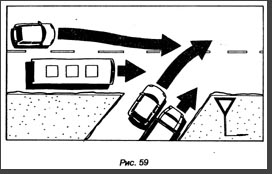 leaves for the second lane, where there is a collision with another car, which completed the advance of the bus (Fig. 59).
leaves for the second lane, where there is a collision with another car, which completed the advance of the bus (Fig. 59).
The driver's mistake is to choose a dangerous trajectory of the turn with the exit immediately to the second lane. The reason for the error is the lack of constant monitoring of the situation (left, rear) and underestimation of the danger closed review generated by the bus.
The likelihood of an accident due to a mistake increases at high speeds and heavy traffic on the main road.
Situation 24. A truck driver, driving on a narrow two-lane road, saw that a passenger car moving in the opposite direction suddenly left ![]() into the opposite lane. To avoid a head-on collision, the driver turns left. At the same time, the passenger car returns to its lane where the collision occurs (Fig. 60). The exit of the passenger car into the oncoming lane was associated with a detour of the damaged section of the road.
into the opposite lane. To avoid a head-on collision, the driver turns left. At the same time, the passenger car returns to its lane where the collision occurs (Fig. 60). The exit of the passenger car into the oncoming lane was associated with a detour of the damaged section of the road.
The driver's mistakes are that, in order to avoid a collision, he drove into the oncoming lane. The reason for the error is an underestimation of the probability that the passenger car will return to its lane. The correct solution in this situation is to slow down and move to the right.
The probability of an accident as a result of an error increases at high vehicle speeds, and also if the driver does not give a warning signal.
Situation 25. A passenger car, moving along the left lane, catches up with a bus. Having given a signal with headlights for the bus to clear the lane, the driver of the car 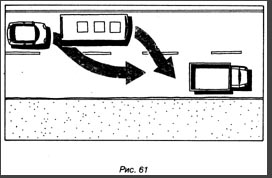 decides that it will be faster to pass the vehicle on the right. Having entered the right lane, the passenger car collides with the bus, as it also began to change lanes to the right (Fig. 61).
decides that it will be faster to pass the vehicle on the right. Having entered the right lane, the passenger car collides with the bus, as it also began to change lanes to the right (Fig. 61).
The driver's mistake is to choose a dangerous overtaking trajectory (right). The reason for the error is an incorrect assumption that the bus will not change lanes to the right.
The probability of making a mistake increases when the bus driver gives a left turn signal late. The likelihood of an accident when making a mistake increases with a sharp overtaking at high speed, slippery road surfaces, and the absence of shoulders on the right.
Self Tests
Did you understand the most difficult situations appearing on the road, and now try to test your prediction skills with tests. Read the descriptions and try to imagine the traffic situation (it's quite simple). Without looking at the comment immediately after the description, determine what danger may be in such a situation, indicate its signs.
Two cars are approaching you. For some reason, the first one slows down without giving any signals. The driver of the second begins to shift slightly to the left. So what is the possibility of danger?
- Skill and traffic safety Driver's professional skills and traffic safety. Features of driving in difficult road and meteorological conditions.
- Driving during rain and snowfall When it rains, road conditions deteriorate significantly - visibility and visibility are limited, the coating becomes not only wet, but liquid mud often appears on it, which acts as a “lubricant” layer and significantly increases the braking distance. Such places are formed mainly where secondary unsurfaced roads adjoin the main asphalt road.
- AT autumn period often rise strong winds. Therefore, the driver must be aware of the features of driving a car associated with wind load.
- Safe Braking Techniques on Slippery Surfaces Many drivers think they have mastered emergency braking techniques. Meanwhile, according to research data, in 25% of cases of collisions with pedestrians there was a technical possibility to avoid it. The reason for this was that in this particular situation, an erroneous method of braking was chosen.
- Features of driving in difficult road and meteorological conditions Weather and climatic conditions have a significant impact on traffic safety, especially in the autumn-winter period, when rain, snowfall and icing of the road surface greatly complicate the operation of the car.
Project news
- Why do motorcyclists crash?
- Opinion: Who is a cyclist and where does he belong
- Tips about tips. Note to the driver
- We continue to prepare for the city: we maneuver on a simple eight.
- Where should PREPARATION for the CITY take place?
Analysis of the causes and circumstances of road accidents The problem of reducing the negative consequences of motorization does not lose its relevance and acuteness for all developed countries, including Belarus.
Reduction problem negative consequences motorization does not lose its relevance and urgency for all developed countries, including Belarus.
Every crash occurs as a result of one or more interrelated causes.
Most of the accidents occur due to the wrong actions of drivers who do not meet traffic safety requirements. Most often, the wrong actions of the driver are explained by an insufficiently attentive attitude to the assessment of driving conditions, ignorance or insufficient consideration of the capabilities of both the driver and the car in these conditions, ignorance or neglect of the requirements of the Rules. traffic.
The prevention of an accident, most often, depends on the driver, on how attentive he is under adverse conditions. road conditions etc.
An analysis of the structure of accidents by types and categories shows that almost half of the accidents were pedestrian collisions. In second place is a collision between vehicles. Such accidents account for almost a third of their total number, and about half of them are frontal. Rollovers, collisions with obstacles and collisions with a cyclist account for about 30% of the total number of accidents.
The greatest severity of consequences is noted in the collision of a train with a vehicle, collision of a vehicle with a cyclist and a pedestrian.
It should be noted that in passing collisions, collisions with an obstacle, a large specific gravity drivers who were able alcohol intoxication.
Of no small importance is the analysis of the distribution of accidents by hours of the day, days of the week and months of the year.
Long-term statistics show that the peak of accidents falls on the period of the day from 17 to 19 hours. The highest severity of consequences is noted for incidents at night in the interval from 01.00 to 06.00, despite the fact that the traffic intensity decreases tenfold. More than 25% of road accidents at this time are made by drivers in a state of intoxication.
The busiest days of the week are Friday, Saturday and Sunday. These days, almost half of the accidents of their total number have been committed. A significant increase in traffic intensity, especially on Friday, the desire of drivers to quickly leave cities for vacation or return from a flight leads to violations of the requirements of the Rules of the Road, especially speed limits, which often leads to tragic consequences.
The largest number of accidents occurred from August to November. The same months are characterized by a high severity of the consequences of an accident.
An analysis of road accidents by places of their occurrence shows that a significant part of them (about 70%) was committed in settlements, and most people die in road accidents in rural settlements. High performance the severity of the consequences of road accidents were recorded in rural settlements and urban-type settlements. In cities of regional subordination, they are almost two times lower.
The vast majority of accidents occurred on roads with asphalt concrete pavement (over 90%) with a relatively low severity of consequences. The most severe consequences were recorded in accidents committed on a cement concrete pavement.
Two-thirds of crashes occur on dry pavement, and about a quarter of crashes occur on wet pavement. A relatively small number of accidents (5-7%) occurred on snow-covered road surfaces and in icy conditions. At the same time, the most severe consequences of an accident.
Almost half of the accidents occurred during daylight hours. At the same time, the most severe consequences of the accident were observed at night. In the absence of lighting on the road, about a third of the accidents of their total number occurred.
The vast majority of accidents occurred on horizontal straight sections of roads (about 90%). 5–6% of accidents were committed at intersections, with the majority at unregulated intersections.
Regulation of pedestrian traffic also affects the number of accidents. If on unregulated pedestrian crossings 8-10% of accidents occurred, then on regulated - almost two times less.
The highest number of accidents in last years occurred due to speeding. A significant number of accidents were committed due to violation of the rules of maneuvering and driving into the oncoming lane.
Drivers of vehicles are responsible for two-thirds of all road accidents. At the same time, twice as many pedestrians die as a result of road accidents than drivers.
It is characteristic that more than half of all accidents committed by drivers occurred in the first hour of their driving, and in the same period, respectively, they die. more of people. However, this time is characterized by minimal severity of consequences. While the incidents that occurred at 5-6 8-9 hours of movement correspond to the greatest severity of the consequences.
More than a quarter of traffic accidents are committed by drivers aged 19-28. The most severe consequences of an accident are typical for drivers over the age of 45.
Every ninth accident is committed by drivers in a state of intoxication. For drunk drivers, such types of accidents as a collision, hitting an obstacle, overturning are typical. It should be noted that the majority of accidents (about 80%) committed by drunk drivers are accounted for by owners of individual vehicles. There is a tendency to increase this type of accident with an increase in driving experience. The minimum number of such accidents is for drivers with less than one year of experience.
Pedestrians are responsible for about one third of the accidents of their total number.
There are five main elements of streets and roads on which the largest number of accidents with pedestrians occurs. In descending order of the number of accidents, these are:
Public transport stop;
Unregulated pedestrian crossing;
Unregulated intersection;
Adjustable pedestrian crossing;
Adjustable intersection.
Among the violations of the Rules of the Road by pedestrians, the most common are: crossing the carriageway in an unspecified place, drunkenness, sudden appearance on the carriageway due to objects restricting visibility.
The distribution of road accident participants by category shows that every fifth participant in an accident is a passenger. Comparative analysis shows that passengers die almost as much as drivers of vehicles and almost twice as many as cyclists and carters. There is a tendency to increase the number of dying passengers.
Children are involved in 10-12% of road accidents.
The analysis shows that half of the accidents are the fault of the children themselves. Moreover, the main reason, as before, is risky behavior on the road, namely, crossing the carriageway outside the established places and unexpectedly appearing in front of moving vehicles.
most dangerous childhood due to participation in an accident falls on the period of 8-11 years.
According to research, among all categories of road users in many countries, child passengers cars accounted for the largest proportion of road fatalities among children (over 70% in Sweden, over 50% in Austria, Spain and France), exceeding the proportion of pedestrian deaths. In the Republic of Belarus, on average, every fourth child involved in an accident is a passenger. The use of special child restraints reduces the likelihood of fatal injuries to child passengers by 45%.
A detailed analysis of all types of road traffic accidents is impossible without identifying all the causes and concomitant factors. All the variety of accidents that happen and can happen on the roads can be described by a diagram (Fig. 7.1). To read this diagram, the following explanations must be made.
A safe road traffic situation is a position and speed of vehicles on the road in which there is no threat to any of the road users.
A dangerous traffic situation is a position and speed of vehicles on the road, in which, as a result of the wrong actions of one of the road users, there is a real threat of a traffic accident, but at the same time it is possible to prevent it.
An emergency road traffic situation is a dangerous situation in which it is impossible to avoid an accident.
Concomitant factors are circumstances that influence the development of the traffic situation, which either alleviate or aggravate the consequences of a traffic accident.
|
Rice. 7.1. Scheme of the origin and development of an accident |
8. First aid
8.1. Basic ideas about body systems and their functioning
To correctly determine the nature and consequences of injuries and to provide effective first aid, it is necessary to know the structure of the body and the activity of its organs. The human body is made up of a number of organs. Their main part is the cell. Thus, the human body is a collection of cells. A collection of cells of the same nature and with the same function form a tissue. There are nerve, muscle, connective and integumentary tissues. Tissues are combined into formations that perform a certain type of activity. These are the so-called apparatuses, organs. In this regard, the body as a collection of organs is called an organism. Organs whose activity is mutually connected form complexes called systems. In the human body, the following systems are distinguished: bone, muscle, digestive, respiratory, genitourinary, vascular, nervous, sensory organs, endocrine system and skin. Each system performs a specific function inherent only to it, but the activity of all systems is interconnected.
The human body functions as a whole. The integrity of the body is expressed in the fact that not only diseased, damaged organs or parts of the body suffer during illness and injury, but the general reaction of the body always manifests itself. This is expressed in a change in the functions of nerve cells and nerve centers, which leads to the entry into the blood of the necessary hormones, vitamins, salts and other substances involved in regulating the vital activity of the body. As a result, its energy and protective capabilities increase. This helps to overcome the violations that have arisen, contributes to their compensation or restoration. A person's attitude to his condition also has a positive or negative effect on the course of a disease process or injury. Active struggle with the disease, optimism improve the course of all life processes, reduce the recovery time, and in case of injuries - help restore impaired functions.
To assess the nature of injuries and the condition of victims of road accidents, it is necessary to know the basics of human physiology and anatomy. Anatomy is the science of structure human body. Physiology - the science of the functioning of organs and systems human body. Knowledge of the basics of these items allows you to competently provide first aid, timely and correctly evacuate the victims to a medical institution. This is of paramount importance for the restoration of their health, and often for the preservation of life.
Skeleton. The skeleton is the collection of all the bones of the body. The skeleton serves as a support for the body, a solid foundation and cover for important organs. The strength and hardness of bones are determined by mineral compounds, mainly phosphorus and calcium, together with organic substances.
The human skeleton consists of more than 200 bones. The surface of the bones is covered on top with a fibrous periosteum containing numerous vessels and nerves. In fractures, bone fragments irritate the nerves of the periosteum, causing significant pain.
Musculature. The movements of the body are carried out with the help of the muscular system, which, together with the bones, forms the so-called motor apparatus.
The main property of muscles is their ability to contract, compress. In this way, the muscle and bone, and with them the entire corresponding part of the body, is set in motion. Muscles that attach to bones are called skeletal muscles and are controlled by willpower.
Blood and vascular apparatus. Blood is a red, opaque liquid. In fact, it is the only liquid tissue in the body. It carries oxygen and nutrients in the body, participates in the fight against infection, maintains body temperature and helps remove decay products from the body. An adult has 5-6 liters of blood, which is approximately 7% of the total body weight.
The blood in the vessels is in constant motion, controlled by the main organ of blood circulation - the heart.
The heart and blood vessels form the cardiovascular system. The task of blood circulation is to deliver the necessary amount of blood to the organs of the body in order to satisfy their need for oxygen and nutrients. Blood by vascular system moves due to the continuous work of the heart. It works like a pressure and suction pump.
The movement of blood is carried out in a closed system through the large and small circles of blood circulation.
When injured, the integrity of the vascular walls is violated and bleeding occurs. With significant bleeding and severe injuries, a violation of blood pressure occurs. A sharp blow to the chest (for example, on the steering wheel of a car when hitting a fixed obstacle or colliding with another car) can cause a heart rupture. The vessels of the liver, spleen, kidneys, pancreas have an important feature: they do not fall off when the organ ruptures and the bleeding that has begun does not stop. When hit in the region of the costal arch on the right and right hypochondrium, a rupture of the liver is possible, in the region of the left costal arch and left hypochondrium - a rupture of the spleen. A blow to the lumbar region may rupture the kidneys and pancreas.
Respiratory system. The human body continuously consumes energy, the source of which is nutrients (proteins, fats and carbohydrates) from food. The energy hidden in these substances is released when they are oxidized in the presence of oxygen, which enters the blood during breathing through the lungs and is carried to all tissues of the body.
The body's daily oxygen consumption at rest is 360 liters. A person inhales with each breath 300-500 ml, approximately 0.5 liters of air, with a deep breath - 1.5-2 liters.
The respiratory organs include the airways (oral cavity, pharynx, larynx, trachea, bronchi) and lungs. The bronchi in the lungs are divided into smaller and smaller ones and the smallest of them end in vesicles - alveoli.
In case of injury, the airways can be blocked, which leads to respiratory arrest. The life of the victim in such cases can only be saved by timely assistance.
A dangerous injury to the respiratory organs is a stab or gunshot wound penetrating into the pleural cavity. The penetration of air into this cavity causes the lungs to collapse and stop their activity. This condition is called pneumothorax. In road accidents, bruises of the chest and fractures of the ribs often occur. The edges of rib fragments can cause rupture of the lungs, which can lead to bleeding into the pleural region or pneumothorax.
Digestive organs. Digestion consists of mechanical (grinding, moisturizing, grinding) and chemical processing of food. Digestion begins in the oral cavity, then food enters the stomach, duodenum, small and large intestines through the esophagus.
A special type of damage to the organs of the digestive tract are foreign bodies, which are swallowed mainly by children. Ingestion of poisons - acids, alkalis - into the digestive tract causes corrosion of the mucous membrane of the oral cavity, esophagus and stomach, and there are even cases of their perforation. A sharp blow to the stomach with a full stomach can cause it to rupture.
Leather. The skin is the covering of the body. It protects the body from the harmful effects of the external environment - bacteria, cold, heat, regulates body temperature; harmful products are removed through the skin, sweat evaporates, it contains a sensitivity apparatus that allows you to perceive touch, heat, cold, pain.
The mechanical action of cutting and piercing objects, foreign bodies, shocks, cold, heat, chemicals is manifested primarily on the skin. Thus arise different kinds damage. However, the skin has an excellent ability to repair damaged cells in the process of wound healing.
Pain sensitive bodies are located not only in the skin, but also in the periosteum, in the peritoneum and in the pleura. When the cause of the pain is removed, the pain itself disappears. This should not be forgotten when providing first aid.
Nervous system. The relationship between organs, fast, accurate and coordinated responses of the body to various stimuli, as well as diverse, coordinated motor acts are provided thanks to nervous system person. It is divided into central, peripheral and autonomic nervous systems. The central nervous system includes the brain and spinal cord. The peripheral nervous system is the nerves along which nerve impulses propagate from the periphery to the nerve centers and in the opposite direction from the nerve centers to all organs. The autonomic or autonomic nervous system regulates the vital processes of the internal organs.
When the brain is damaged, there are violations of motor functions, mental disorders, and in severe cases, death. In case of damage to large nerves and the spinal cord, complete or partial paralysis of parts of the body below the injury occurs, i.e. inability to voluntary movements.





